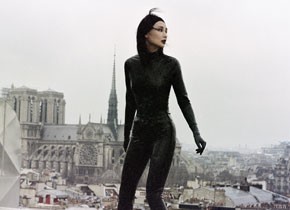Olivier Assayas
The Complete Works
May 11 to June 17, 2012
“What interests me in cinema is not cinema itself, but what cinema, as an exploratory tool, catches in its nets.” (Olivier Assayas)
With two new publications and a retrospective of his work, the Austrian Film Museum pays tribute to an artist who, over the past three decades, has established himself as one of the most extraordinary voices in cinema. For Olivier Assayas, film is the art of constant upheaval, of restlessness, and accordingly, his work can’t be easily labeled. Between his first feature Désordre (1986) and such major works as Irma Vep (1996), Les Destinées sentimentales (2000) demonlover (2002) and, most recently, L’Heure d’été (2008) and Carlos (2010), he has charted an exciting and highly dialectical path, “embracing narrative and character, dealing with the fragmentary reality of life in a global economy, and, at the same time, crafting what amounts to an ongoing, passionate spiritual autobiography.“ (Kent Jones). Or, in the words of the filmmaker: „I believe that in art you can move from the intimate to the universal. You can make movies that deal with what is going on within yourself, which is part of commonly shared human experience, and simultaneously you can make movies that are open to what happens in the big world around you, that deal with history, with the geo-politics of your time.“
Assayas was born in Paris in 1955, to a family with Hungarian and Italian roots. His father (pen name: Jacques Rémy) was a busy screenwriter in the film and TV industry, but the son took a different path towards cinema: from rock music and painting (his first chosen art form) to a deep engagement with the legacy of Guy Debord and Situationism, to film criticism. As a writer for Cahiers du cinéma between 1980 and 1985, he was partly responsible for some of the magazine’s legendary special issues. In Made in Hong-Kong (1984), for instance, he demonstrated a deep understanding of Chinese film culture, which went far beyond other contemporary perspectives. Later, he published a book of interviews with Ingmar Bergman (1990) and a short monograph on Kenneth Anger (1999), which, along with his documentary HHH – Portrait de Hou Hsiao-hsien (1997), can be viewed as a “cinephile trilogy.” Assayas’ autobiographical book of 2005, A Post-May Adolescence, is now being released by the Film Museum in an English edition. In many ways, it also serves as a companion text to Assayas’ upcoming film, Aprés-Mai.
Since Une nouvelle vie (1993), all of Assayas' films have attempted to capture the world anew through cinema, to connect with lived experience in the most intricate ways. At the same time, they reflect on specific film genres and eras – three obvious examples are Les Destinées sentimentales (his 19th century epic), Clean (2004; his “New Hollywood film”) and Carlos (his political Euro-thriller). But none of these works are simply hommages; they are fragile acts of self-realization, staking out positions, keeping track of the filmmaker’s own transformation as a human being. If Assayas’ so-called typical (or "typically French”) works – L’Enfant de l‘hiver (1989), Fin août, début septembre (1998), L'Heure d'été (2008) – are marked by moments of change, or by a quivering between fear and hope, then his "untypical, international" films, such as the fabulous "film maudit" demonlover and the B-thriller Boarding Gate (2007), serve as variations on this theme.
The key to Assayas' work so far can be found in a masterful pair of films, L'Eau froide (1994) and Irma Vep. The former, deeply autobiographical, pays tribute to teenage life in the early 70s, and to the night as a zone of freedom, listening to music, dancing and hanging out; the latter presents cinema as a machine of illusions, which, if handled properly, can guide us directly to the core of reality. With L'Eau froide, Assayas developed the fluidity of his gaze, that observant gliding which has characterized his movies ever since; in Irma Vep he gave free reign to his love for formal experimentation, culminating in a final apotheosis of personal filmmaking which also feels like a rediscovery of the medium. Perhaps L'Eau froide was a farewell to the kind of person one can no longer be, while Irma Vep is an acceptance of what one became instead. And the movement continues.
The Film Museum is honored to welcome Oliver Assayas for a masterclass and several Q&As during the opening weekend of the retrospective. The new monograph on the filmmaker, edited by Kent Jones, and Assayas’ book "A Post-May Adolescence" will be launched on May 11 in the presence of both authors. The retrospective and publications have been organized with kind support from the French Institute in Paris and the Institut français in Austria.
Related materials
Photos 2012 - Olivier Assayas
Books Olivier Assayas


